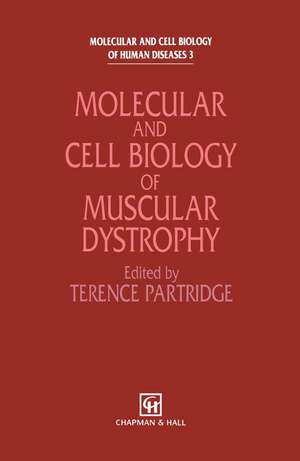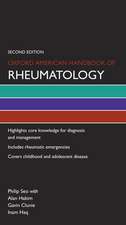Molecular and Cell Biology of Muscular Dystrophy: Molecular and Cell Biology of Human Diseases Series
Editat de T. Partridgeen Limba Engleză Hardback – 31 iul 1993
| Toate formatele și edițiile | Preț | Express |
|---|---|---|
| Paperback (1) | 1219.94 lei 6-8 săpt. | |
| SPRINGER NETHERLANDS – 2 noi 2012 | 1219.94 lei 6-8 săpt. | |
| Hardback (1) | 1226.11 lei 6-8 săpt. | |
| SPRINGER NETHERLANDS – 31 iul 1993 | 1226.11 lei 6-8 săpt. |
Preț: 1226.11 lei
Preț vechi: 1495.25 lei
-18% Nou
Puncte Express: 1839
Preț estimativ în valută:
234.64€ • 240.30$ • 195.19£
234.64€ • 240.30$ • 195.19£
Carte tipărită la comandă
Livrare economică 19 martie-02 aprilie
Preluare comenzi: 021 569.72.76
Specificații
ISBN-13: 9780412434402
ISBN-10: 0412434407
Pagini: 344
Ilustrații: XVI, 344 p.
Dimensiuni: 155 x 235 x 21 mm
Greutate: 0.69 kg
Ediția:1993
Editura: SPRINGER NETHERLANDS
Colecția Springer
Seria Molecular and Cell Biology of Human Diseases Series
Locul publicării:Dordrecht, Netherlands
ISBN-10: 0412434407
Pagini: 344
Ilustrații: XVI, 344 p.
Dimensiuni: 155 x 235 x 21 mm
Greutate: 0.69 kg
Ediția:1993
Editura: SPRINGER NETHERLANDS
Colecția Springer
Seria Molecular and Cell Biology of Human Diseases Series
Locul publicării:Dordrecht, Netherlands
Public țintă
ResearchCuprins
1 Molecular human genetics and the Duchenne/Becker muscular dystrophy gene.- 1.1 Introduction.- 1.2 DMD and BMD phenotype.- 1.3 Localization to Xp21.- 1.4 Isolation of Xp21 sequences.- 1.5 Chromosome walking and jumping in Xp21.- 1.6 Identification of expressed sequences.- 1.7 Gene sequence and organization.- 1.8 Genotype and phenotype.- 1.9 Dystrophin.- 1.10 Conclusions.- References.- 2 Genotype/phenotype correlations in Duchenne/Becker dystrophy.- 2.1 Introduction.- 2.2 Duchenne muscular dystrophy.- 2.3 Dystrophinopathy in girls and women.- 2.4 Becker muscular dystrophy.- 2.5 Conclusion.- References.- 3 Molecular genetics and genetic counselling for Duchenne/Becker muscular dystrophy.- 3.1 Introduction.- 3.2 Duchenne and Becker muscular dystrophy.- 3.3 Genetic counselling for Duchenne and Becker muscular dystrophy: prior to molecular genetics.- 3.4 Genetic counselling of Duchenne and Becker muscular dystrophy post molecular genetics.- 3.5 Genetic counselling of Duchenne and Becker muscular dystrophy: Future.- 3.6 Conclusion.- Acknowledgements.- References.- 4 Inheritance and pathogenicity of myotonic dystrophy.- 4.1 Introduction.- 4.2 The clinical picture.- 4.3 Biochemical, electrophysiological and histological findings.- 4.4 Genetic mapping of the myotonic locus.- 4.5 Physical mapping.- 4.6 Isolation of the DM region as a series of overlapping genomic clones.- 4.7 Identifying candidate genes.- 4.8 Future prospects.- Acknowledgements.- References.- 5 Genetic mapping of facioscapulohumeral muscular dystrophy.- 5.1 Introduction.- 5.2 Positional cloning.- 5.3 Facioscapulohumeral muscular dystrophy: clinical features.- 5.4 FSHD: Linkage analysis and positional cloning.- Acknowledgements.- References.- 6 Dystrophin-associated glycoproteins: their possible roles in the pathogenesis of Duchenne muscular dystrophy.- 6.1 Introduction.- 6.2 Membrane properties of dystrophin.- 6.3 Dystrophin—glycoprotein complex.- 6.4 Structure and function of dystroglycan (43/156 dystrophin-associated glycoprotein).- 6.5 Molecular pathogenesis of Duchenne muscular dystrophy.- 6.6 Summary.- Acknowledgements.- References.- 7 PCR analysis of muscular dystrophy in mdx mice.- 7.1 Introduction.- 7.2 Mouse dystrophin cDNA clones.- 7.3 mdx mice.- 7.4 PCR analysis of mouse dystrophin expression.- 7.5 Summary.- Acknowledgements.- References.- 8 Cell biology of the satellite cell.- 8.1 Introduction.- 8.2 Satellite cells in normal muscle.- 8.3 Behaviour of satellite cells in damaged muscle.- 8.4 Satellite cells, myoblasts and implant therapy.- References.- 9 Molecular and cell biology of skeletal muscle regeneration.- 9.1 Introduction.- 9.2 Developmental origin of satellite cells and their identification in vivo.- 9.3 Replication during postnatal growth.- 9.4 Numbers and proliferative capacity of mpc from animals of different ages.- 9.5 The influence of growth factors and extracellular matrix components on the proliferation and differentiation of mpc.- Acknowledgements.- References.- 10 Molecular mechanisms of muscle damage.- 10.1 Introduction.- 10.2 The mechanisms of damage to normal skeletal muscle subjected to various damaging stresses.- 10.3 Mechanisms of damage in dystrophin-deficient muscle.- 10.4 Conclusions.- Acknowledgements.- References.- 11 Human dystrophin gene transfer: Genetic correction of dystrophin deficiency.- 11.1 Somatic gene therapy: An introduction.- 11.2 Therapeutic targets in Duchenne muscular dystrophy.- 11.3 Recombinant dystrophin genes: Their nature and availability.- 11.4 Physical gene transfer techniques.- 11.5 Viral-mediated gene transferstrategies.- 11.6 Studies in transgenic animals: Germ line gene transfer.- 11.7 Dystrophin: Structure and function.- 11.8 Gene therapy for Duchenne muscular dystrophy: Future prospects.- References.- 12 Myoblast transplantation in inherited myopathies.- 12.1 Introduction.- 12.2 Myoblast transplantation in animal models of inherited myopathies.- 12.3 Problems associated with myoblast transfer.- Acknowledgements.- References.














